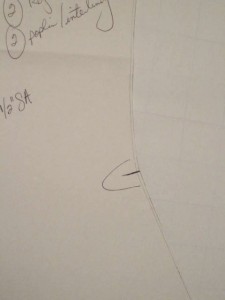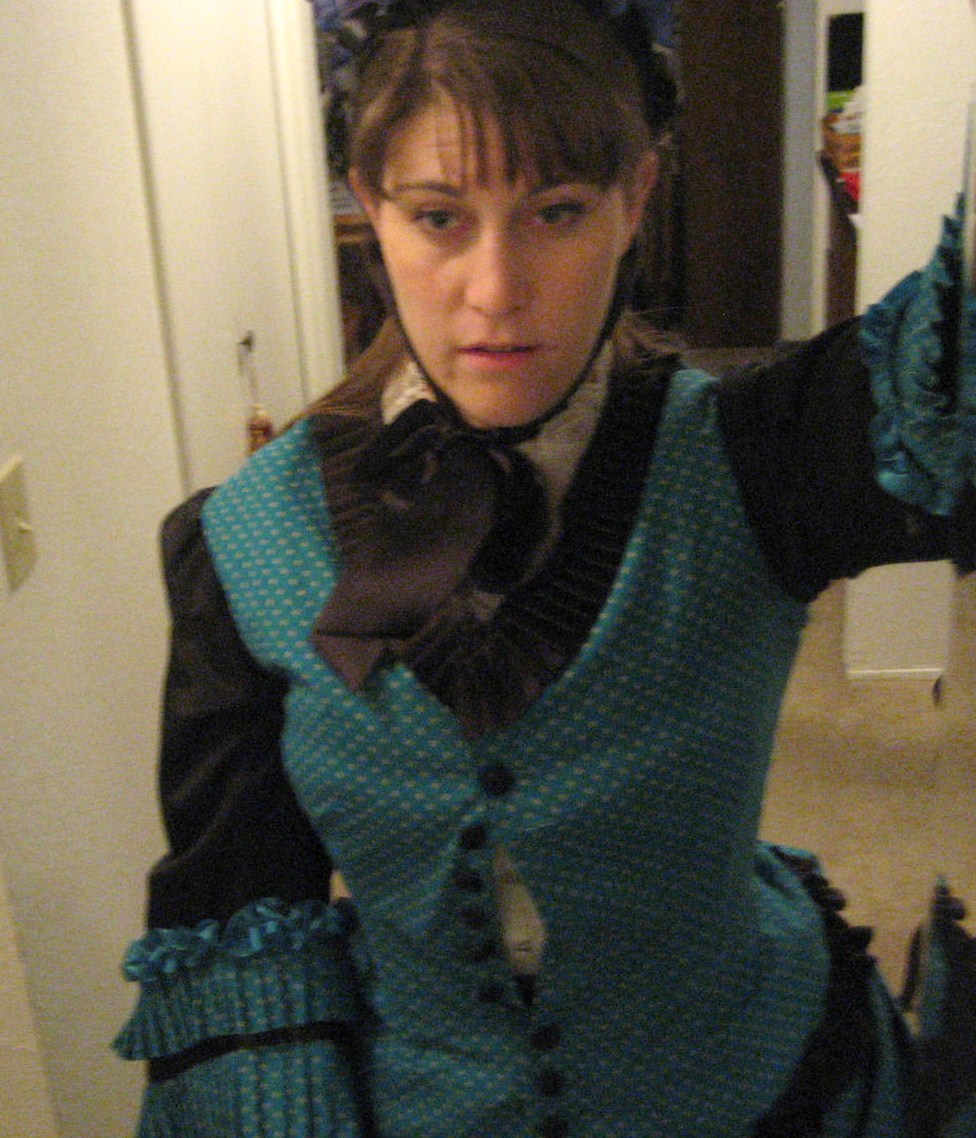
Ever have that moment when you’re dressing for an event only to put on your bodice and the front doesn’t close? And you’re cinched down in your corset as far as you can go? Yeah, me too.
You know the mockup was perfect. You spent hours fine tuning the darts and armhole. Now it won’t close. arghhhh……
So what do you do to prevent this problem next time? (Secrets given away below, ssshhh…)
The simple answer is that no additional ease was built into your mockup/pattern to allow for construction.
Sure, the wearing ease is there or you wouldn’t have been able to move in your mockup. The trial run garment was fit to your figure but the problem started when you cut out the fabric, underlining and put in boning.
When you flat line (add an underlining layer) and add in one or more bones, the garment will “shrink” on you. Heavier historical fabrics create thicker seam allowances. Bones and their casings add another layer, thereby reducing the circumference of the garment to go around the body. When you try on the final product, it seems to fit just a little too tight (and those pesky buttons are hard to close).
All those different layers need room to sit around your body. I call this Historical Ease when sewing non-modern fashions.
The ease adjustments below (which have been tested over many years) will keep that perfectly fitted garment to original measurements, no matter how thick your fabric, how many layers you use, and how many bones you insert.
Please note these are suggestions only and should be changed or adapted to your individual project.
Bodice Ease:
- 5/8” to ¾” suggested total ease
During the fitting of your costume in muslin (the mockup), make the fit as close as the time period requires. Make sure the torso area lies flat against the body with no gaping. Be careful that you don’t tighten the bodice so much that the seams are stressed. Adding ease will not help this error.
- Take your pattern and add the ease measurement (spread out over the pattern circumference) around the bust/chest area. Do this by taking your desired ease (5/8” to 3/ 4” total ease amount) and dividing by the number of seams. (You are thinking of the entire bodice here and not just half of it as your pattern probably only represents half where you cut two layers of fabric at once.)
Usually you will add to the centers and side seams. Sometimes you may only have to add ease to the center front and possibly side seams. This technique takes time and practice before you know what kind and how much ease to add to different tight-fitting bodices and gowns.
Tip: if your bodice is fine as is with thin fabrics and you are only adding bones at the side seams, you could get away with just adding ease to those seam edges on your pattern instead of adding to all the seams. The ease at the sides only will take into the boning thickness there and keep your bodice fitted nicely.
Example: You have a bodice with a center front opening (1), two side seams (2) and single back princess seams (2) which gives you 5 seams.
5/8” (or 0.625) ÷ 5 = 0.125 or 1/8” per seam (This is very important!)
This means you add 1/8” each to the center front, side seams and back princess seams. In modern pattern drafting, add this amount equally to each piece.
In other words, add 1/16” to the left side of bodice center front and 1/16” to the right side bodice center front. Add 1/16” to the bodice front at the side seam and 1/16” to the back piece at the side seam. Each of those 1/16” additions equals the 1/8” ease allowance needed at each seam. Each 1/8” you add to each seam (5 in the example) equals the 5/8” ease allowance.

This bodice pattern has 1/16” added for historical ease. So along this seam is an additional 1/8” for ease (1/16″ on each side of the seam). Note: It is extremely difficult to add less than 1/16” to a pattern piece. Human error will not figure it in while sewing and the ease will “disappear” on you.
If you have multiple seams, unless you are adding a great deal of ease to allow for heavy wool or lots of bones, most often you do not need to count these design seams into your ease calculations. Use the basic seams of centers, side seams and princess seams.
- Add your ease amount vertically from the bust point area/armhole down to the waistline. This is the area around the body that will require the extra ease due to bones. Taper your addition back to the original line above and below this area. You do not need historical ease at the neckline or hipline – this is built into your pattern during fittings.
- Add historical ease to your final completed pattern that includes seam allowances. Just draw the ease line to the outside of the original cut line. Then cut around your pattern including the ease in your fabric piece.
*Key to Adding Ease: Taper your added ease back to the top and bottom edges of each pattern piece. This way the armhole and hemline will not change.
So the next time you fit a bodice, after you make your alterations to the pattern, remember to add in Historical Ease. You’ll have less risk of popping off a button.
Miss Part 1? Read it here: Struggling to Get That Waistband Closed?
Read Part 3: Not Inclined to Dance – I Can’t Move My Arms!


In historical garments, have you seen boning added to all those sheer white lawn bodices?
Yes. Usually there is a fitted lining that’s boned. The sheer outer fabric is mounted over it. If an Edwardian dress is sheer completely, it was worn over a boned under bodice.
This is a very helpful article, Jennifer. My question is my continued problem with fitting. You see, I’m never the same size on any day. I will measure myself on Tuesday, having two people help me get the correct measure. On Wednesday I will be as much as two inches larger or smaller. I’ve been re-fitting the bodice for days now. I get it right, then I go back a day later to tweak it and it’s wrong again.
Building in ease helps. I had it fitted exactly right yesterday. It looked good and felt good. Today the waist is too high and the front won’t close because I’m an inch larger. I don’t think I’m going to be able to do more than an approximate fit. Have you ever had a student with this problem? How was it solved?
If your waistline is fluctuates in height it seems like your corset is not sitting in the same spot each time you put it on. Can’t think of what else would change that. Perhaps simply use the corset to smooth out your silhouette rather than for cinching. In other words, keep your corset a bit loose around you so functionally it’s there to provide a stable base for your bodice to fit around. Then you’ll have a bit of room to ease “in and out of shape.” I think your “approximate fit” might be best. Allow wide seam allowances at the side seams for quick adjustments.
Oh, and make sure whenever you put on your corset you give yourself a good 15 minutes or more to settle into it. Don’t try to do a fitting or put on a fitted bodice until your body has adjusted to the restriction. Afterwards, cinch in the extra the develops… because it will.
I have a hard time with ease! Thanks for the tips!